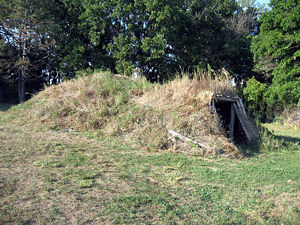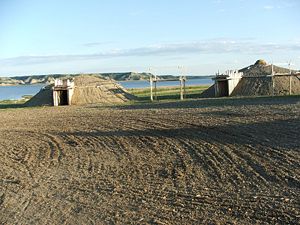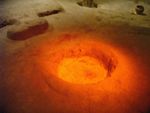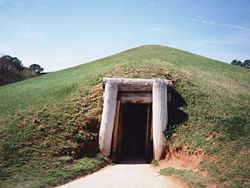Difference between revisions of "Earth lodge" - New World Encyclopedia
| Line 49: | Line 49: | ||
In [[Kanabec County, Minnesota]], there is a [[Groundhouse River (Minnesota)|Groundhouse River]]. According to Newton H. Winchell in ''The Aborigines of Minnesota'', the river was thus named due to the earth lodges of the [[Hidatsa]], who lived in the area before being driven westward to the [[Missouri River]] by the [[Sioux]]. The Hidatsa lived in wooden huts covered with earth. | In [[Kanabec County, Minnesota]], there is a [[Groundhouse River (Minnesota)|Groundhouse River]]. According to Newton H. Winchell in ''The Aborigines of Minnesota'', the river was thus named due to the earth lodges of the [[Hidatsa]], who lived in the area before being driven westward to the [[Missouri River]] by the [[Sioux]]. The Hidatsa lived in wooden huts covered with earth. | ||
| + | |||
| + | ==Notes== | ||
| + | <references/> | ||
==References== | ==References== | ||
| − | |||
==External links== | ==External links== | ||
Revision as of 23:13, 7 January 2012
An earth lodge is a semi-subterranean building covered partially or completely with earth, best known from the Native American cultures of the Great Plains and Eastern Woodlands. Most earth lodges are circular in construction with a dome-like roof, often with a central or slightly offset smoke hole at the apex of the dome. Earth lodges are well-known from the more sedentary tribes of the Plains, such as the Hidatsa, Mandan, and Arikara, but they have also been identified archaeologically among sites of the Mississippian culture in the Eastern United States.
Structure
Earth lodges were typically constructed using a wattle and daub technique with a particularly thick coating of earth. The dome-like shape of the earth lodge was achieved by the use of angled or carefully bent tree trunks, although hipped roofs were also sometimes used. During construction, the workers would dig an area of land a few feet beneath the surface, allowing the entire building to have a floor somewhat beneath the surrounding ground level. They set posts into holes in the ground around the edges of the earth lodge, and made the tops meet in or near the middle. The construction technique is sturdy, and can produce quite large buildings (some as much as 60 feet across) in which more than one family would live. The size is limited somewhat by the length of available tree trunks. Internal vertical support posts were sometimes used to give additional structural support to the roof rafters.
After a strong layer of sticks or reeds was wrapped through and over the radiating roof timbers, the people often applied a layer of thatch as part of the roof. The structure was then entirely covered in earth. The earth layer and the partially subterranean foundation provided insulation against the extreme temperatures of the Plains.
Use by Plains Native Americans
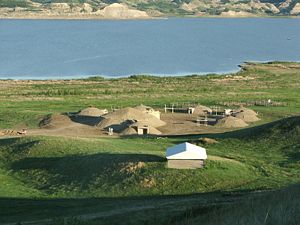
Earth lodges were a common dwelling for Native American tribes of the upper Midwest. Most specifically the Mandan, the Hidatsa and Arikara.
The origin of the upper midwest Earthlodge is generally attributed to the Mandan tribe, who were a sedentary farming and trading tribe. Later when the Hidatsa came into the area they adopted the earthen structures. The Arikara, a Caddoan speaking Pawnee tribe, were builders of earthlodges long before they arrived in North Dakota.
These structures were a familiar sight to traders and explorers along the banks of the little Missouri, and were found in city clusters of up to a thousand such earthen homes.
These structures consisted of a clay outer shell, over an inner shell of long grasses and a woven willow ceiling. The very middle of the Earthlodge was used as a fire pit and a hole was built into the center. This smoke hole was often covered by a bullboat during inclement weather.
Logs were generally gathered each spring as the ice receded and sheared them off, fresh logs were also cut. The most common wood used, traditionally speaking, was Cottonwood. Cottonwood being such a wet and soft wood meant that lodges often required re-building every 6-8 years.
Many would be surprised to learn that the men only raised the large logs, and the rest of the back breaking work was left to the woman. As such a lodge was considered to be "owned" by the female who built it.
A vestibule of exposed logs marked the entrance and provided an entryway, these vestibules were often a minimum of 6' in length to about 9' in length, which was determined by the size of the lodge and resulting outer clay thickness.
Generally a windbreak was built on the interior of the lodge, blocking wind and giving privacy to the occupants. In addition, earthlodges often contained Cache pits, or root cellar type holes, lined with willow and grasses - within which dried vegetables were stored.
They were most often found alongside tribal farm fields as well, alternating with tipis - which were used during the nomadic hunting season of the year. An entire Earthlodge village can be seen at New Town, North Dakota.
The village consists of six family sized earthlodges and one large ceremonial earthlodge. In addition, a garden area and horse corrals have been built to add to the authenticity. This park is open to the public and located west of New Town at the Earthlodge Village Site. The family Earthlodges are roughly 40' in diameter, while the Ceremonial Earthlodge is 90' plus in diameter, it is also the largest such structure in the world. The park is the central point in a rebuilding and cultural renewal effort by the Three Affiliated Tribes of the Fort Berthold Indian Reservation. This is the only village of its kind to be constructed by the Mandan, Hidatsa and Arikara nations in over a hundred years.
In addition, a reconstructed earth lodge can be seen at the Glenwood, Iowa Lake Park.
Use by the Mississippian culture
Ocmulgee (pronounced "oak-mull-ghee") is a memorial to ancient indigenous peoples in Southeast North America. From Ice Age hunters to the Muscogee (Creek) of historic times, the site has evidence of 17,000 years of human habitation. The Macon plateau was inhabited during the Paleoindian, Archaic, and Woodland phases.
The major occupation was ca. 950-1150 during the Early Mississippian-culture phase. The people of this sophisticated, stratified culture built the complex, massive earthworks that expressed their religious and political system.[1] Archeologists call this society the Macon Plateau culture, a local expression of the Mississippian culture.[2] During this period, an elite society supported by skillful farmers constructed a town. Leaders directed the complex construction of large, earthwork mounds, the central structures on the plateau.
Carrying earth by hand in bags, thousands of workers built the 55 ft (17 m).-high Great Temple Mound on a high bluff overlooking the floodplain of the Ocmulgee River. Magnetometer scans have revealed the platform mound had a spiraling staircase oriented toward the floodplain. The staircase is unique among any of the Mississippian-culture sites. Other earthworks include at least one burial mound.
The people built rectangular wooden buildings to house certain religious ceremonies on the platform mounds. The mounds at Ocmulgee were unusual because their distance apart from each other was more than that of other Mississippian complexes. Scholars believe this was to provide for public space and residences.
Circular earth lodges were built to serve as places to conduct meetings and important ceremonies. Remains of one of the earth lodges were carbon dated to 1050 C.E. This evidence was the basis for the reconstructed lodge which archeologists later built at the monument center. The interior features a raised-earth platform, shaped like an eagle with a forked-eye motif. Molded seats on the platform were built for the leaders. The eagle was a symbol of the Southeastern Ceremonial Complex, which the people shared with other Mississippian cultures.
A number of major Mississippian mound centers have identified earth lodges either beneath (i.e. preceding) the mound construction or as a mound-top building. Sequential constructions, collapses, and rebuilding of earth lodges seems to be part of the mechanism of construction for certain mounds, including the mound at Town Creek Indian Mound and some of the mounds at Ocmulgee National Monument.
In Kanabec County, Minnesota, there is a Groundhouse River. According to Newton H. Winchell in The Aborigines of Minnesota, the river was thus named due to the earth lodges of the Hidatsa, who lived in the area before being driven westward to the Missouri River by the Sioux. The Hidatsa lived in wooden huts covered with earth.
Notes
- ↑ David J. Holly, "Macon Plateau", in Archaeology of Prehistoric Native America: An Encyclopedia, p. 601
- ↑ Macons Mississippians. Retrieved 2010-01-16.
ReferencesISBN links support NWE through referral fees
External links
| |||||
Credits
New World Encyclopedia writers and editors rewrote and completed the Wikipedia article in accordance with New World Encyclopedia standards. This article abides by terms of the Creative Commons CC-by-sa 3.0 License (CC-by-sa), which may be used and disseminated with proper attribution. Credit is due under the terms of this license that can reference both the New World Encyclopedia contributors and the selfless volunteer contributors of the Wikimedia Foundation. To cite this article click here for a list of acceptable citing formats.The history of earlier contributions by wikipedians is accessible to researchers here:
The history of this article since it was imported to New World Encyclopedia:
Note: Some restrictions may apply to use of individual images which are separately licensed.
